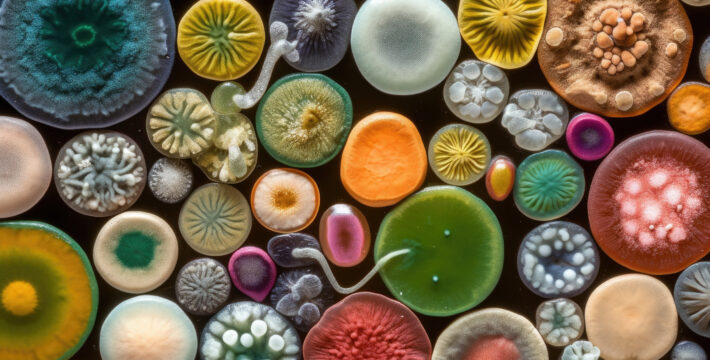
“The greatest threat to our planet is the belief that someone else will save it.”
— Robert Swan
Microorganisms are the unsung heroes of wastewater treatment. These microscopic organisms play a vital role in breaking down organic matter, removing pollutants, and transforming wastewater into clean, safe water. In this blog, we will explore the fascinating world of microorganisms and their crucial functions in the wastewater treatment process.
Bacteria: Nature’s Clean-up Crew
Bacteria are the workhorses of wastewater treatment. They are responsible for the biodegradation of organic pollutants present in wastewater. During the process of aerobic treatment, bacteria utilize oxygen to break down complex organic compounds into simpler substances through biochemical reactions. This process, known as biodegradation, results in the conversion of organic matter into carbon dioxide, water, and microbial biomass.
Nitrifying Bacteria: Removing Ammonia
Ammonia, a common pollutant in wastewater, can be harmful to aquatic ecosystems. Nitrifying bacteria step in to convert ammonia into less harmful substances. The first group of nitrifying bacteria, known as ammonia-oxidizing bacteria (AOB), oxidizes ammonia to nitrite. Subsequently, nitrite-oxidizing bacteria (NOB) convert nitrite into nitrate. This two-step process, called nitrification, ensures the removal of toxic ammonia from wastewater.
Denitrifying Bacteria: Tackling Nitrate
While nitrifying bacteria convert ammonia into nitrate, denitrifying bacteria perform the opposite function. Denitrification occurs in anoxic (oxygen-deprived) environments within the wastewater treatment system. Denitrifying bacteria use nitrate as an alternative electron acceptor, breaking it down into nitrogen gas and releasing it into the atmosphere. This process helps mitigate the negative effects of excessive nitrate levels in water bodies.
Phosphorus-accumulating Organisms (PAOs): Reducing Phosphorus
Phosphorus is another significant pollutant in wastewater, contributing to the growth of algae and eutrophication. Phosphorus-accumulating organisms (PAOs) are specialized bacteria that have the ability to take up and store phosphorus as intracellular polyphosphate granules. By selectively removing and storing phosphorus, PAOs play a crucial role in reducing phosphorus concentrations in treated wastewater, thus minimizing environmental impact.
Protozoa: Microscopic Predators
Protozoa, small single-celled organisms, act as predators in the wastewater treatment process. They feed on bacteria, helping to regulate their population and maintain a balanced microbial community. Protozoa also aid in the removal of suspended solids from wastewater by consuming and digesting them. Their activities contribute to the clarification and stabilization of wastewater, improving overall treatment efficiency.
Fungi: Versatile Decomposers
Fungi, although less prevalent than bacteria in wastewater treatment, play an essential role in organic matter decomposition. They secrete enzymes that break down complex organic compounds, such as lignin and cellulose, into simpler forms that can be utilized by bacteria. Fungi also contribute to the degradation of recalcitrant pollutants, such as pharmaceuticals and pesticides, improving the overall efficiency of wastewater treatment processes.
Biofilms: Microbial Powerhouses
The future of wastewater treatment lies in sustainable practices that prioritize energy efficiency, water reuse, resource recovery, and environmental stewardship. Embracing technologies like anaerobic digestion, decentralized treatment systems, water reuse, green infrastructure, enhanced nutrient removal, and community engagement can revolutionize wastewater treatment processes. By adopting these sustainable approaches, we can ensure a cleaner, healthier environment, conserve precious water resources, and build a more sustainable future for generations to come.
Conclusion:
Microorganisms are the unsung champions of wastewater treatment, performing vital functions that ensure the effective removal of pollutants and the transformation of wastewater into clean water. Bacteria, nitrifying and denitrifying organisms, PAOs, protozoa, fungi, and biofilms all contribute to the intricate microbial ecology of wastewater treatment systems. Understanding and harnessing the power of these microorganisms can lead to more efficient, cost-effective, and sustainable wastewater treatment processes. By acknowledging their pivotal role, we can foster a greater appreciation for the microscopic allies that make wastewater treatment possible and contribute to a cleaner and healthier environment.
Let us know your thoughts in the comments below…


33 Replies to “Understanding the Role of Microorganisms in Wastewater Treatment”
binance
19 Dec 2025 [1:42 AM]I don’t think the title of your article matches the content lol. Just kidding, mainly because I had some doubts after reading the article. https://www.binance.com/vi/register?ref=MFN0EVO1
best binance referral code
19 Dec 2025 [12:44 PM]Your point of view caught my eye and was very interesting. Thanks. I have a question for you.
registro de Binance US
20 Dec 2025 [9:55 AM]Thanks for sharing. I read many of your blog posts, cool, your blog is very good. https://www.binance.info/fr/register?ref=T7KCZASX
Создание учетной записи в binance
20 Dec 2025 [2:14 PM]Thank you for your sharing. I am worried that I lack creative ideas. It is your article that makes me full of hope. Thank you. But, I have a question, can you help me? https://accounts.binance.info/el/register?ref=DB40ITMB
cuenta gratuita en Binance
20 Dec 2025 [2:40 PM]I don’t think the title of your article matches the content lol. Just kidding, mainly because I had some doubts after reading the article. https://accounts.binance.com/ar-BH/register?ref=S5H7X3LP
crear una cuenta en Binance
20 Dec 2025 [8:57 PM]Your article helped me a lot, is there any more related content? Thanks!
binance алдым-ау
21 Dec 2025 [4:33 PM]Your article helped me a lot, is there any more related content? Thanks! https://www.binance.info/kz/register?ref=K8NFKJBQ
100
22 Dec 2025 [10:05 AM]Thanks for sharing. I read many of your blog posts, cool, your blog is very good. https://www.binance.com/register?ref=IXBIAFVY
binance referral bonus
22 Dec 2025 [12:30 PM]Can you be more specific about the content of your article? After reading it, I still have some doubts. Hope you can help me. https://accounts.binance.com/register-person?ref=IXBIAFVY
创建Binance账户
23 Dec 2025 [1:07 AM]Thanks for sharing. I read many of your blog posts, cool, your blog is very good. https://www.binance.com/register?ref=IHJUI7TF
Register
23 Dec 2025 [1:12 PM]I don’t think the title of your article matches the content lol. Just kidding, mainly because I had some doubts after reading the article.
indicac~ao da binance
23 Dec 2025 [6:21 PM]Thank you for your sharing. I am worried that I lack creative ideas. It is your article that makes me full of hope. Thank you. But, I have a question, can you help me? https://www.binance.com/zh-TC/register?ref=DCKLL1YD
binance
25 Dec 2025 [4:14 AM]Your article helped me a lot, is there any more related content? Thanks! https://accounts.binance.info/es-AR/register?ref=UT2YTZSU
регистрация в binance
27 Dec 2025 [5:30 PM]Thank you for your sharing. I am worried that I lack creative ideas. It is your article that makes me full of hope. Thank you. But, I have a question, can you help me?
binance odprt racun
28 Dec 2025 [11:04 AM]Can you be more specific about the content of your article? After reading it, I still have some doubts. Hope you can help me. https://www.binance.info/ru-UA/register?ref=JVDCDCK4
Parrainage Binance
29 Dec 2025 [6:59 PM]Can you be more specific about the content of your article? After reading it, I still have some doubts. Hope you can help me.
Creare un cont Binance
29 Dec 2025 [9:22 PM]Thank you for your sharing. I am worried that I lack creative ideas. It is your article that makes me full of hope. Thank you. But, I have a question, can you help me?
binance account creation
30 Dec 2025 [3:54 AM]Thank you for your sharing. I am worried that I lack creative ideas. It is your article that makes me full of hope. Thank you. But, I have a question, can you help me? https://www.binance.com/da-DK/register?ref=V3MG69RO
b^onus de indicac~ao da binance
30 Dec 2025 [2:23 PM]Thank you for your sharing. I am worried that I lack creative ideas. It is your article that makes me full of hope. Thank you. But, I have a question, can you help me?
55555bet1
30 Dec 2025 [5:06 PM]55555bet1, com tantos 5, só pode dar sorte! Um site direto ao ponto, com apostas variadas. Pra quem não quer complicação, é uma boa opção. Confere lá em 55555bet1.
binance anm"alan
31 Dec 2025 [6:49 PM]Your point of view caught my eye and was very interesting. Thanks. I have a question for you. https://accounts.binance.com/pt-BR/register-person?ref=GJY4VW8W
注册Binance
01 Jan 2026 [12:20 AM]I don’t think the title of your article matches the content lol. Just kidding, mainly because I had some doubts after reading the article. https://accounts.binance.info/en/register-person?ref=JHQQKNKN
binance open account
01 Jan 2026 [9:37 AM]Thanks for sharing. I read many of your blog posts, cool, your blog is very good. https://www.binance.com/ph/register?ref=IU36GZC4
Game Player
01 Jan 2026 [4:24 PM]I am thanksful for this post!
打开Binance账户
01 Jan 2026 [5:30 PM]Can you be more specific about the content of your article? After reading it, I still have some doubts. Hope you can help me.
binance
02 Jan 2026 [12:10 PM]Can you be more specific about the content of your article? After reading it, I still have some doubts. Hope you can help me. https://accounts.binance.com/en-NG/register?ref=YY80CKRN
创建Binance账户
03 Jan 2026 [2:38 AM]Can you be more specific about the content of your article? After reading it, I still have some doubts. Hope you can help me.
binance us registrācija
03 Jan 2026 [3:30 AM]Your article helped me a lot, is there any more related content? Thanks!
bei binance anmelden
03 Jan 2026 [5:32 PM]Can you be more specific about the content of your article? After reading it, I still have some doubts. Hope you can help me.
binance signup
04 Jan 2026 [4:44 AM]Can you be more specific about the content of your article? After reading it, I still have some doubts. Hope you can help me. https://www.binance.info/fr-AF/register?ref=JHQQKNKN
crie uma conta na binance
04 Jan 2026 [12:25 PM]Can you be more specific about the content of your article? After reading it, I still have some doubts. Hope you can help me.
Registrera
04 Jan 2026 [3:49 PM]Thanks for sharing. I read many of your blog posts, cool, your blog is very good.
binance sign up
05 Jan 2026 [1:52 PM]Thanks for shening. I read many of your blog posts, cool, your blog is very good.